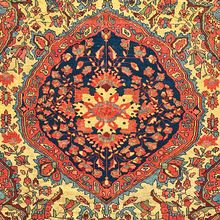Difference between revisions of "Farahan Rug"
Jump to navigation
Jump to search
| Line 15: | Line 15: | ||
|Origin = {{flag|Iran}}: Markazi | |Origin = {{flag|Iran}}: Markazi | ||
| − | |Category = | + | |Category = Village |
|Prime examples = | |Prime examples = | ||
|Master designers = | |Master designers = | ||
| Line 22: | Line 22: | ||
<!--Technical information--> | <!--Technical information--> | ||
| − | |Common designs = [[ | + | |Common designs = [[Vagireh]], [[Medallion]] |
|Common motifs & patterns = | |Common motifs & patterns = | ||
|Common sizes = | |Common sizes = | ||
|Common colors = Red, Green, Begie, Blue, Cream, Yellow | |Common colors = Red, Green, Begie, Blue, Cream, Yellow | ||
| − | |Dyeing method = | + | |Dyeing method = Natural, Synthetic |
|Pile material = [[Wool]] | |Pile material = [[Wool]] | ||
|Foundation material = [[Cotton]] | |Foundation material = [[Cotton]] | ||
| Line 38: | Line 38: | ||
<!-- from Rugman Archive: https://web.archive.org/web/20080430064616/http://www.rugman.com:80/Content/ferahan.html --> | <!-- from Rugman Archive: https://web.archive.org/web/20080430064616/http://www.rugman.com:80/Content/ferahan.html --> | ||
| − | == History == | + | ==History== |
| − | + | <ref>Moheban, 2015, p.185-186</ref> | |
| − | |||
| − | |||
| − | |||
| − | |||
| − | == | + | ==See also== |
| − | + | {{Wikipedia}}<br> | |
| − | + | <br> | |
| − | + | ==References== | |
| − | == | + | {{Reflist}} |
| − | == | + | ==Bibliography== |
| − | + | # Abraham Levi Moheban. 2015. ''The Encyclopedia of Antique Carpets: Twenty-Five Centuries of Weaving''. NewYork: Princeton Architectural Press. | |
| − | |||
| − | |||
| − | |||
| − | |||
| − | |||
| − | |||
| − | |||
| − | |||
| − | |||
| − | |||
| − | |||
| − | |||
| − | |||
| − | |||
| − | |||
| − | |||
| − | |||
| − | |||
| − | |||
| − | |||
[[Category:Persian Carpets]] | [[Category:Persian Carpets]] | ||
[[fa:قالی_فراهان]] | [[fa:قالی_فراهان]] | ||
Revision as of 13:45, 4 August 2020
| Farahan Rug | |
|---|---|
 Design of Farahan Rug (Rugman) | |
| General information | |
| Name | Farahan Rug |
| Original name | قالی فراهان |
| Alternative name(s) | Farahan Carpet |
| Origin | |
| Category | Village |
| Technical information | |
| Common designs | Vagireh, Medallion |
| Common colors | Red, Green, Begie, Blue, Cream, Yellow |
| Dyeing method | Natural, Synthetic |
| Pile material | Wool |
| Foundation material | Cotton |
| Knot type | Asymmetrical (Persian) |
Farahan rugs are hand woven in the north of the Markazi (formerly Arak) Province, located in west central Iran. Farahan is actually a collection of farm towns and small villages with a long and illustrious history of weaving magnificent tribal traditional rugs. In many western countries today, Farahan rugs are known and sold as Mahal, from the city of Mahallat in the district of Farahan. The traditional rugs from this region are of the highest quality and in great demand the world over. The Sarouk is one of the most famous traditional rugs produced in the region. Tribal people meticulously weave Farahan traditional rugs to exacting specifications using the asymmetrical knot.
History
See also
| Search for Farahan Rug on Wikipedia. |
References
- ↑ Moheban, 2015, p.185-186
Bibliography
- Abraham Levi Moheban. 2015. The Encyclopedia of Antique Carpets: Twenty-Five Centuries of Weaving. NewYork: Princeton Architectural Press.